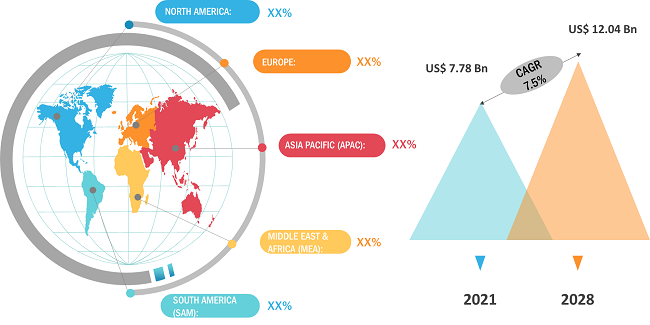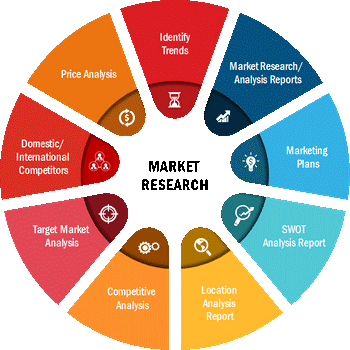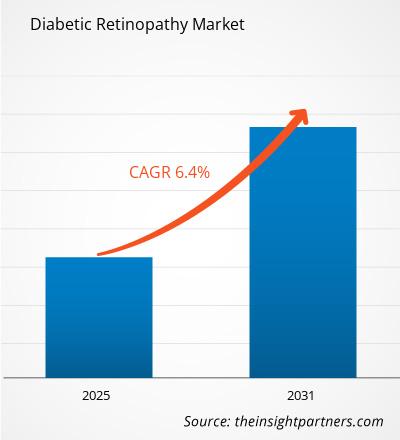El mercado de la retinopatía diabética es se espera que crezca de 7.780 millones de dólares en 2021 a 12.040 millones de dólares en 2031; se espera que crezca a una tasa compuesta anual del 6,5 % entre 2022 y 2031.
La diabetes es una de las enfermedades no transmisibles más comúnmente diagnosticadas. La creciente incidencia de diabetes se ha atribuido al crecimiento del retinopatía diabética ; mercado. La retinopatía diabética se caracteriza por visión borrosa y ceguera debido a que los niveles elevados de azúcar dañan la retina. La retinopatía diabética se caracteriza por visión borrosa y ceguera debido a que los niveles altos de azúcar dañan la retina. Según datos de los Centros para el Control y la Prevención de Enfermedades (CDC), la retinopatía diabética afecta aproximadamente a un tercio de las personas con diabetes mayores de 40 años, y más de 4,2 millones de pacientes viven actualmente en los EE. UU. con retinopatía diabética. Como resultado, los líderes del mercado están trabajando en el desarrollo de tratamientos innovadores para la retinopatía diabética y se están investigando una amplia variedad de nuevos tratamientos relacionados. Por ejemplo, en mayo de 2021, Regeneron Pharmaceuticals, Inc. recibió la aprobación de la FDA para EYLEA® (Aflibercept) Inyección para el tratamiento de la retinopatía diabética.
DINÁMICA DEL MERCADO
El crecimiento del mercado de la retinopatía diabética es Se atribuye principalmente a la creciente prevalencia de diabetes, el aumento de la población geriátrica y el aumento de casos de retinopatía diabética. Sin embargo, la lenta aprobación de los medicamentos y la falta de oftalmólogos capacitados están obstaculizando el crecimiento del mercado.
ÁMBITO DEL MERCADO
El “Análisis del mercado global de retinopatía diabética hasta 2031” El informe tiene como objetivo proporcionar una descripción general del mercado de la retinopatía diabética con una segmentación detallada del mercado según el tipo, el tratamiento y el canal de distribución. El informe proporciona estadísticas clave del mercado basadas en el desempeño de los principales actores. También ofrece tendencias y oportunidades clave en el mercado.
Perspectivas estratégicas
SEGMENTACIÓN DEL MERCADO
El mercado mundial de la retinopatía diabética está segmentado por tipo, tratamiento y distribución. Según el tipo, el mercado se divide en retinopatía diabética proliferativa y retinopatía diabética no proliferativa. Según el tratamiento, el mercado se segmenta en fármaco anti-VEGF, esteroides inyección, cirugías láser y vitrectomía. Según el canal de distribución, el mercado se segmenta en farmacias minoristas, farmacias hospitalarias y otros.
< span style="font-family: verdana, geneva, sans-serif; font-size: 10pt;">
El mercado mundial de la retinopatía diabética está segmentado en cinco regiones principales: América del Norte, Europa, Asia Pacífico, Medio Oriente y Asia. África y el Sur y el Sur. Centroamérica. El informe cubre análisis y pronósticos de 18 países de todo el mundo junto con las tendencias y oportunidades que prevalecen en estas regiones.
América del Norte dominó el mercado de la retinopatía diabética con una participación de ~38% en 2021. El crecimiento del mercado en la región se atribuye principalmente a la presencia de una enorme población diabética junto con la presencia de actores líderes del mercado como como Abbott Laboratories, Alimera Science, Allergan Plc, Regeneron Pharmaceuticals Inc. y Pfizer. La siguiente figura muestra la tendencia de crecimiento de los ingresos en el mercado de la retinopatía diabética de América del Norte:
 Fuente: The Insight Partners Analysis
Fuente: The Insight Partners Analysis
El informe analiza factores que afectan, como impulsores, restricciones y oportunidades. y tendencias futuras que impactan el mercado de la retinopatía diabética. También proporciona un análisis PEST exhaustivo de los factores que afectan el mercado de la retinopatía diabética.
IMPACTO DE LA PANDEMIA DE COVID-19
La pandemia de COVID-19 afectó negativamente al mercado de la retinopatía diabética. Provocó perturbaciones en los centros de salud, especialmente en las clínicas de oftalmología. Las visitas ambulatorias se redujeron durante la pandemia, lo que resultó en un diagnóstico tardío de retinopatía diabética, lo que finalmente resultó en una menor demanda de medicamentos para la retinopatía diabética. Según el estudio de Strata Decision Technology, el mercado de la oftalmología perdió el 81% del volumen durante la primera ola de COVID-19. Además, aproximadamente el 30 % de los pacientes con retinopatía diabética faltaron a visitas clínicas durante la pandemia.
Además, el cierre de unidades de fabricación, el drástico declive económico, los cierres nacionales, el cierre de instalaciones logísticas, el retraso en los ensayos clínicos y la disminución de los procedimientos de diagnóstico son otros factores principales responsables de la disminución de la demanda de retinopatía diabética. El aplazamiento de las actividades de ventas, la reducción de las actividades de I+D realizadas por los líderes para lanzar productos avanzados y los reveses económicos experimentados por los pacientes provocaron una disminución drástica en el crecimiento del mercado durante el año 2021. Sin embargo, se prevé que el mercado se recupere a mediados de 2022. ya que se observa la progresión de la diabetes en los pacientes durante el período COVID-19, lo que en última instancia resulta en un aumento en la tasa de incidencia de la retinopatía diabética. Junto con esto, el desempeño positivo de los principales medicamentos para la retinopatía diabética durante los primeros trimestres de 2022 también indica la recuperación del mercado de la retinopatía diabética.
JUGADORES DEL MERCADO
El informe cubre novedades clave en el mercado de la retinopatía diabética. Varias empresas se están centrando en estrategias de crecimiento orgánico, como lanzamientos de productos, aprobaciones de productos, patentes y eventos. Las estrategias de crecimiento inorgánico, como adquisiciones, asociaciones y colaboraciones, han fomentado la expansión de los negocios y la base de clientes de los actores del mercado. Se prevé que los actores del mercado que operan en el mercado de la retinopatía diabética experimenten lucrativas oportunidades de crecimiento en los próximos años con la creciente demanda de medicamentos para la retinopatía diabética.
El informe también incluye los perfiles de las empresas clave del mercado de la retinopatía diabética, junto con su análisis FODA y estrategias de mercado. También se centra en los principales actores de la industria con información como perfiles de empresas, componentes y servicios ofrecidos, información financiera de los últimos tres años y desarrollos clave en los últimos cinco años. La lista de algunas empresas dedicadas al mercado de medicamentos para la retinopatía diabética se menciona a continuación:
- Laboratorios Abbott
- Alimera Science
- Allergan Plc
- Ampio Pharmaceuticals
- Bayer AG
- F. Hoffmann-LA Roche
- Novartis International AG
- PFIZER
- Regeneron Pharmaceuticals Inc
- Valeant Pharmaceutical
El equipo dedicado de investigación y análisis de Insight Partner está formado por profesionales experimentados con conocimientos estadísticos avanzados y ofrece varias opciones de personalización en el estudio existente.

- Análisis histórico (2 años), año base, pronóstico (7 años) con CAGR
- Análisis PEST y FODA
- Tamaño del mercado Valor/volumen: global, regional, nacional
- Industria y panorama competitivo
- Conjunto de datos de Excel



Report Coverage
Revenue forecast, Company Analysis, Industry landscape, Growth factors, and Trends

Segment Covered
This text is related
to segments covered.

Regional Scope
North America, Europe, Asia Pacific, Middle East & Africa, South & Central America

Country Scope
This text is related
to country scope.
Preguntas frecuentes
The diabetic retinopathy market is estimated to grow with a CAGR of 6.4% from 2023 to 2031
The diabetic retinopathy market majorly consists of players such as Abbott Laboratories, Alimera Science, Allergan Plc among others
Asia-Pacific region is likely to witness the fastest growth rate during the forecast period.
The market drivers include the increasing prevalence of diabetes and rising geriatric population, which are driving the diabetic retinopathy market
Personalised medicine is likely to remain the key trend during the forecast period.
North America dominated the diabetic retinopathy market in 2023
Trends and growth analysis reports related to Life Sciences : READ MORE..
The List of Companies
- Abbott Laboratories
- Alimera Science
- Allergan Plc
- Ampio Pharmaceuticals
- Bayer AG
- F. Hoffmann-LA Roche
- Novartis International AG
- PFIZER
- Regeneron Pharmaceuticals Inc
- Valeant Pharmaceutical
The Insight Partners performs research in 4 major stages: Data Collection & Secondary Research, Primary Research, Data Analysis and Data Triangulation & Final Review.
- Data Collection and Secondary Research:
As a market research and consulting firm operating from a decade, we have published and advised several client across the globe. First step for any study will start with an assessment of currently available data and insights from existing reports. Further, historical and current market information is collected from Investor Presentations, Annual Reports, SEC Filings, etc., and other information related to company’s performance and market positioning are gathered from Paid Databases (Factiva, Hoovers, and Reuters) and various other publications available in public domain.
Several associations trade associates, technical forums, institutes, societies and organization are accessed to gain technical as well as market related insights through their publications such as research papers, blogs and press releases related to the studies are referred to get cues about the market. Further, white papers, journals, magazines, and other news articles published in last 3 years are scrutinized and analyzed to understand the current market trends.
- Primary Research:
The primarily interview analysis comprise of data obtained from industry participants interview and answers to survey questions gathered by in-house primary team.
For primary research, interviews are conducted with industry experts/CEOs/Marketing Managers/VPs/Subject Matter Experts from both demand and supply side to get a 360-degree view of the market. The primary team conducts several interviews based on the complexity of the markets to understand the various market trends and dynamics which makes research more credible and precise.
A typical research interview fulfils the following functions:
- Provides first-hand information on the market size, market trends, growth trends, competitive landscape, and outlook
- Validates and strengthens in-house secondary research findings
- Develops the analysis team’s expertise and market understanding
Primary research involves email interactions and telephone interviews for each market, category, segment, and sub-segment across geographies. The participants who typically take part in such a process include, but are not limited to:
- Industry participants: VPs, business development managers, market intelligence managers and national sales managers
- Outside experts: Valuation experts, research analysts and key opinion leaders specializing in the electronics and semiconductor industry.
Below is the breakup of our primary respondents by company, designation, and region:

Once we receive the confirmation from primary research sources or primary respondents, we finalize the base year market estimation and forecast the data as per the macroeconomic and microeconomic factors assessed during data collection.
- Data Analysis:
Once data is validated through both secondary as well as primary respondents, we finalize the market estimations by hypothesis formulation and factor analysis at regional and country level.
- Macro-Economic Factor Analysis:
We analyse macroeconomic indicators such the gross domestic product (GDP), increase in the demand for goods and services across industries, technological advancement, regional economic growth, governmental policies, the influence of COVID-19, PEST analysis, and other aspects. This analysis aids in setting benchmarks for various nations/regions and approximating market splits. Additionally, the general trend of the aforementioned components aid in determining the market's development possibilities.
- Country Level Data:
Various factors that are especially aligned to the country are taken into account to determine the market size for a certain area and country, including the presence of vendors, such as headquarters and offices, the country's GDP, demand patterns, and industry growth. To comprehend the market dynamics for the nation, a number of growth variables, inhibitors, application areas, and current market trends are researched. The aforementioned elements aid in determining the country's overall market's growth potential.
- Company Profile:
The “Table of Contents” is formulated by listing and analyzing more than 25 - 30 companies operating in the market ecosystem across geographies. However, we profile only 10 companies as a standard practice in our syndicate reports. These 10 companies comprise leading, emerging, and regional players. Nonetheless, our analysis is not restricted to the 10 listed companies, we also analyze other companies present in the market to develop a holistic view and understand the prevailing trends. The “Company Profiles” section in the report covers key facts, business description, products & services, financial information, SWOT analysis, and key developments. The financial information presented is extracted from the annual reports and official documents of the publicly listed companies. Upon collecting the information for the sections of respective companies, we verify them via various primary sources and then compile the data in respective company profiles. The company level information helps us in deriving the base number as well as in forecasting the market size.
- Developing Base Number:
Aggregation of sales statistics (2020-2022) and macro-economic factor, and other secondary and primary research insights are utilized to arrive at base number and related market shares for 2022. The data gaps are identified in this step and relevant market data is analyzed, collected from paid primary interviews or databases. On finalizing the base year market size, forecasts are developed on the basis of macro-economic, industry and market growth factors and company level analysis.
- Data Triangulation and Final Review:
The market findings and base year market size calculations are validated from supply as well as demand side. Demand side validations are based on macro-economic factor analysis and benchmarks for respective regions and countries. In case of supply side validations, revenues of major companies are estimated (in case not available) based on industry benchmark, approximate number of employees, product portfolio, and primary interviews revenues are gathered. Further revenue from target product/service segment is assessed to avoid overshooting of market statistics. In case of heavy deviations between supply and demand side values, all thes steps are repeated to achieve synchronization.
We follow an iterative model, wherein we share our research findings with Subject Matter Experts (SME’s) and Key Opinion Leaders (KOLs) until consensus view of the market is not formulated – this model negates any drastic deviation in the opinions of experts. Only validated and universally acceptable research findings are quoted in our reports.
We have important check points that we use to validate our research findings – which we call – data triangulation, where we validate the information, we generate from secondary sources with primary interviews and then we re-validate with our internal data bases and Subject matter experts. This comprehensive model enables us to deliver high quality, reliable data in shortest possible time.

 Obtenga una muestra gratuita de este informe
Obtenga una muestra gratuita de este informe